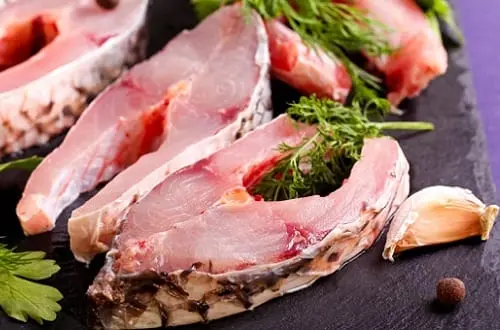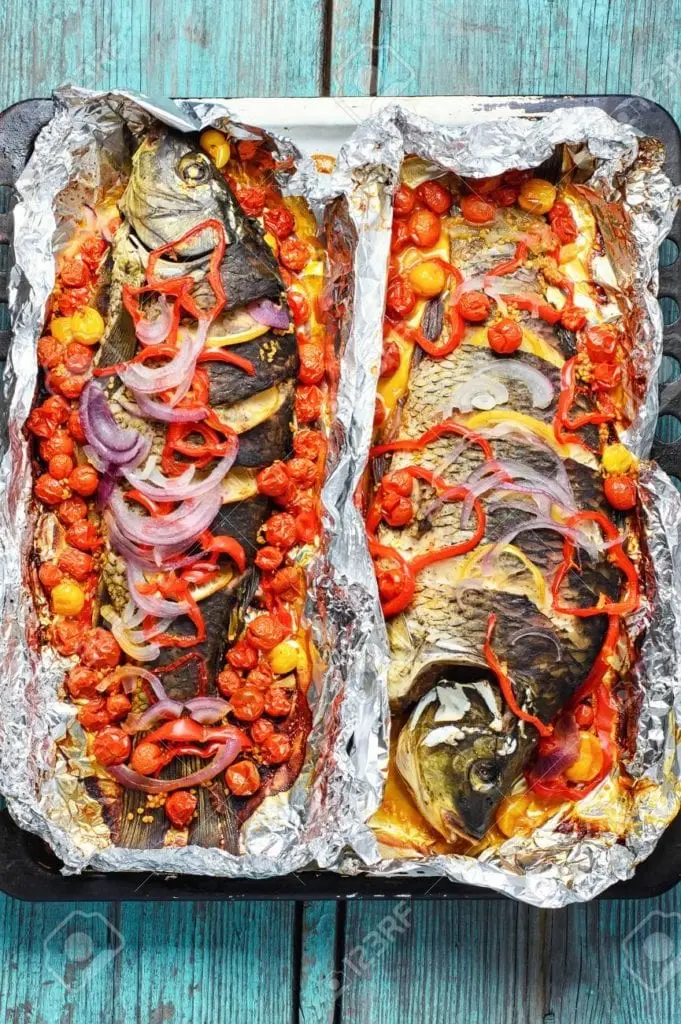Contents
Carp is a large omnivorous fish of the carp family. The fish has a large elongated body with golden brown scales. Another distinctive feature is the small antennae on either side of the mouth. Carp is common throughout the world, so there are many different ways to prepare it. The most common dish is carp baked in foil. Also, fish is stuffed with a mixture of eggs, flour and vegetables; In Asian cuisine, carp are turned inside out skin inside and fried in boiling oil.
History
In China, carp was used as food as early as 1000 BC. A little later, this fish was brought to the territory of Europe, where carp was considered both an ornamental fish and a food product. The first ponds for growing and breeding carp appeared in Bohemia in the 13th century, and under Francis I, who ruled from 1494 to 1547, they began to be bred in France. Currently, carps are grown in almost all countries: this business is very profitable, since carps are fertile, unpretentious and grow very quickly.
Beneficial features
Carp meat is very rich in valuable minerals and vitamins: it contains vitamins PP and B12, sulfur, iodine, cobalt, phosphorus, zinc and chromium. Its use in food is extremely beneficial for the thyroid gland, digestive and nervous systems, brain, mucous membranes, skin. Carp meat helps to normalize blood sugar levels.
Like many other foods high in B12, carp is an antioxidant, promotes fat metabolism, and in case of chronic hypoxia or its exacerbation, it increases the consumption of oxygen by cells.
- Caloric value 112 kcal
- Protein 16 g
- Fat 5.3 g
- Carbohydrates 0 g
- Dietary fiber 0 g
- Water 77 g
Application

Carps are sold in outlets around the world almost all year round. They can be eaten boiled, baked, or fried. Experienced nutritionists believe that the high fat content of carp meat should be compensated by serving this fish with herbs, vegetables and lemon.
From the heads, tails, fins and bones remaining after gutting carp, a rich and aromatic broth is obtained. Cooks advise to cook carp meat not in small, but in large pieces, placing them in cold water: this way the meat will turn out to be more tasty and juicy. Fried carp will be much tastier if left on.
How to choose fresh carp
Nothing is fresher than live fish, so if possible catch carp in the pond or take carp from an aquarium or tank (if you buy it outside). In this case, choose the most active individuals. By activity, you can judge how healthy each particular fish is.
If you are a lousy fisherman, and you sell live carp once a year, then when choosing a fish, follow the following tips:
Check the gills, and if they don’t look like hot pink and bright red, walk by. In addition to this, the gills should be of normal shape. Sticky gills are a sign of corruption.
Look for clear, bulging eyes (if the fish is not frozen) where water is still visible.
Fresh carp will have moist scales and whole skin. In this case, the mucus should be transparent and slippery. Stickiness, damage and discoloration indicate that the fish is stale.

Feel the carp from all sides. It must be elastic.
You can try to smell the fish, but the reliability of this procedure is questionable, because today flavors are capable of anything.
There should be no blood on the fish at all. A couple of small specks are allowed. Otherwise, a sick carp can get on your table.
The quality of frozen carp can be assessed even by the glaze: even and without cracks – everything is fine, bumpy and cracked – the fish was stored incorrectly. However, with dry freezing, there will be no glaze at all. But fresh carp in this case should look like a smooth stone.
Unnatural spotting of a carcass is a sign of spoilage or improper freezing.
Contraindications to the use of carp

Farmed carp is a type of fish that is saturated with omega-6 fatty acids and practically no omega-3 acids. That it is better for hypertensive patients, heart patients and cancer patients to treat carp with caution.
P.S. If the bones of carp, which have not yet been subjected to heat treatment, are too easily separated from the meat surrounding them, then such a fish is unusable. Therefore, do not regret the money spent and throw the spoiled product in the trash can. Health is more expensive.
Well, if the carp is fresh, then try to find outstanding culinary skills in yourself and cook something delicious …
Carp baked in foil

Ingredients
- Carp – 1 kg;
- Cherry tomatoes – 10 pieces;
- Small onions – 8 pieces;
- Olives – 12 pieces;
- Medium carrots – 2 pieces;
- Parsley greens – 0.5 bunch;
- Salt to taste;
- Lemon juice;
- Vegetable oil;
- Seasoning for fish;
- Sour cream – 1 tbsp. (optional).
Step by step recipe
- Prepare the food you need.
- Scale the fish, gut it carefully so as not to damage the gallbladder, remove the gills and eyes.
- Rinse the fish well under cold water and pat dry with a paper towel. Rub inside and out with salt and spices and drizzle with lemon juice. Refrigerate the fish for at least an hour so that it is well saturated with salt and spices.
- Peel the onions and carrots. Cut the carrots into circles, cut the onions in half or into quarters.
- Wash and dry the parsley.
- Cut the tomatoes into two halves.
- Cover the baking sheet with foil and grease it with a little vegetable oil.
- On chilled and marinated fish, use a sharp knife to make several longitudinal cuts to the ridge.
- Transfer the carp to a lined baking sheet with foil. Put some onions, carrots, a sprig of parsley and a few olives in the belly.
- Place the remaining onions, carrots and olives around the fish, alternating with cherry tomatoes and parsley leaves.
- Wrap the fish in foil, tightly joining the edges of the foil.
- Bake the fish in an oven preheated to 180 degrees for about 40-50 minutes. Then remove the baking sheet from the oven, gently unfold the foil and brush the fish with 1 tablespoon. sour cream.
- Then send the baking sheet with fish back to the oven and bake for another 10-15 minutes to form a golden brown crust.
- Gently transfer the cooked carp and baked vegetables to a platter. Pour the juice on top of the fish and bake carp with vegetables in the oven
- Garnish with lemon slices and fresh parsley. Recipe for baked carp in foil
- A bright, juicy and tasty fish dish is ready! Enjoy your meal!









